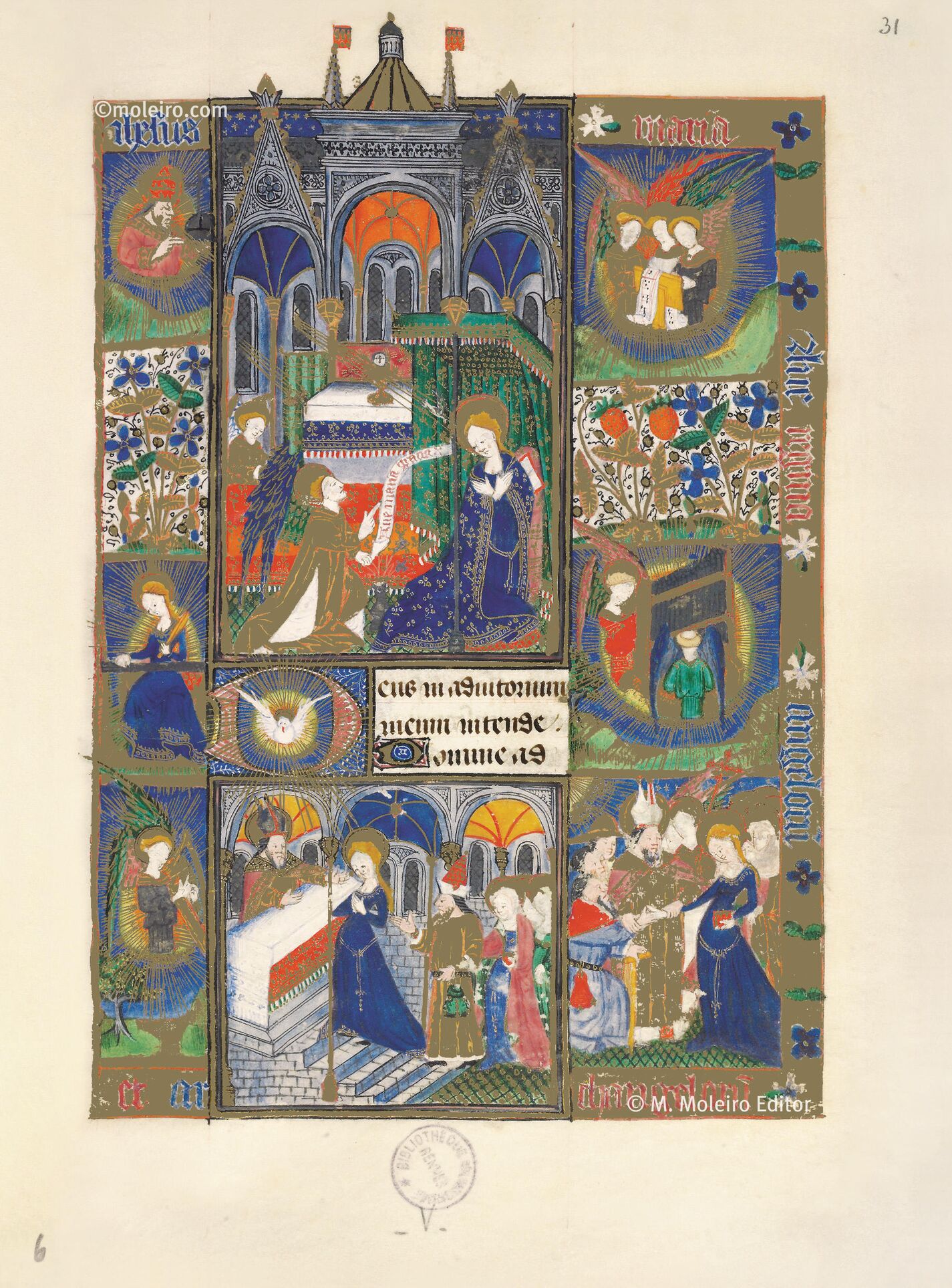The Annunciation of the kneeling Mary, dressed in a very beautiful blue robe under a mantle, is shown in the centre of the folio, in a church's architectural space between two triangular pediments flanking a square tower. There is an altar covered with a white cloth on which stands a chalice with sacramental bread above. Mary, with her arms crossed over her breast, turns away from an open book placed on a lectern to listen to an angel's message, himself kneeling. He is pointing towards Mary and holding a scroll inscribed with the well-known salutation Ave Maria (Hail Mary), with behind him an accompanying angel. In the top left corner, as in the miniature of folio 21r, is the triple-crowned God the Father, the source of the rays of light directed to the Virgin. These rays carry a minuscule white figure close to the head of Mary, illustrating conventionally the descent of the soul of Jesus. This is one of the symbolic representations of the Incarnation which was much appreciated in Western religious art in the later Middle Ages.
Facing God the Father, at the same height, is a trio of angels closely grouped together, holding between them a white parchment with a musical score.
At mid-level, we find again the Dove, facing forwards in flight and painted within the capital D of Deus in adiutorium meum intende ('Oh God, come to my assistance', taken from Psalm 69:2 in the Vulgate). On the left sits a young woman saint holding scissors, clearly the Virgin Mary at her loom, and on the right an angel is placed behind an organ on which another angel, tonsured and winged, is playing. These angels echo, so to speak, the choir of three singing above, lending emphasis to this hour of celestial joy.
Right at the foot of the folio, Mary, with clasped hands, mounts three steps to an altar where a bishop welcomes her. Behind Mary is a figure in a tall hat with a purse at his belt, followed by a group of the faithful accompanying the Virgin as she is about to dedicate herself to the service of the Temple.
To the left of this scene is an angel and to the right a bishop, blessing Mary and Joseph's union (Joseph without a halo) and joining their hands in the presence of a good number of figures with haloes grouped behind Mary. It could be that this miniature is meant to represent the vow of perpetual virginity made by Mary in the presence of a representative of the Church's hierarchy, with the consent of Joseph and in his presence. This scene only spread in the West, towards the end of the Middle Ages, showing the marriage of Mary and Joseph before a Jewish high priest, in this case a bishop. It is unknown in Eastern Christian art.
Three sides of the frame carry a Latin inscription: Ihesus Maria, Ave regina angelorum et archangelorum ('Jesus Mary, Hail queen of angels and archangels').

The Annunciation of the kneeling Mary, dressed in a very beautiful blue robe under a mantle, is shown in the centre of the folio, in a church's architectural space between two triangular pediments flanking a square tower. There is an altar covered with a white cloth on which stands a chalice with sacramental bread above. Mary, with her arms crossed over her breast, turns away from an open book placed on a lectern to listen to an angel's message, himself kneeling. He is pointing towards Mary and holding a scroll inscribed with the well-known salutation Ave Maria (Hail Mary), with behind him an accompanying angel. In the top left corner, as in the miniature of folio 21r, is the triple-crowned God the Father, the source of the rays of light directed to the Virgin. These rays carry a minuscule white figure close to the head of Mary, illustrating conventionally the descent of the soul of Jesus. This is one of the symbolic representations of the Incarnation which was much appreciated in Western religious art in the later Middle Ages.
Facing God the Father, at the same height, is a trio of angels closely grouped together, holding between them a white parchment with a musical score.
At mid-level, we find again the Dove, facing forwards in flight and painted within the capital D of Deus in adiutorium meum intende ('Oh God, come to my assistance', taken from Psalm 69:2 in the Vulgate). On the left sits a young woman saint holding scissors, clearly the Virgin Mary at her loom, and on the right an angel is placed behind an organ on which another angel, tonsured and winged, is playing. These angels echo, so to speak, the choir of three singing above, lending emphasis to this hour of celestial joy.
Right at the foot of the folio, Mary, with clasped hands, mounts three steps to an altar where a bishop welcomes her. Behind Mary is a figure in a tall hat with a purse at his belt, followed by a group of the faithful accompanying the Virgin as she is about to dedicate herself to the service of the Temple.
To the left of this scene is an angel and to the right a bishop, blessing Mary and Joseph's union (Joseph without a halo) and joining their hands in the presence of a good number of figures with haloes grouped behind Mary. It could be that this miniature is meant to represent the vow of perpetual virginity made by Mary in the presence of a representative of the Church's hierarchy, with the consent of Joseph and in his presence. This scene only spread in the West, towards the end of the Middle Ages, showing the marriage of Mary and Joseph before a Jewish high priest, in this case a bishop. It is unknown in Eastern Christian art.
Three sides of the frame carry a Latin inscription: Ihesus Maria, Ave regina angelorum et archangelorum ('Jesus Mary, Hail queen of angels and archangels').